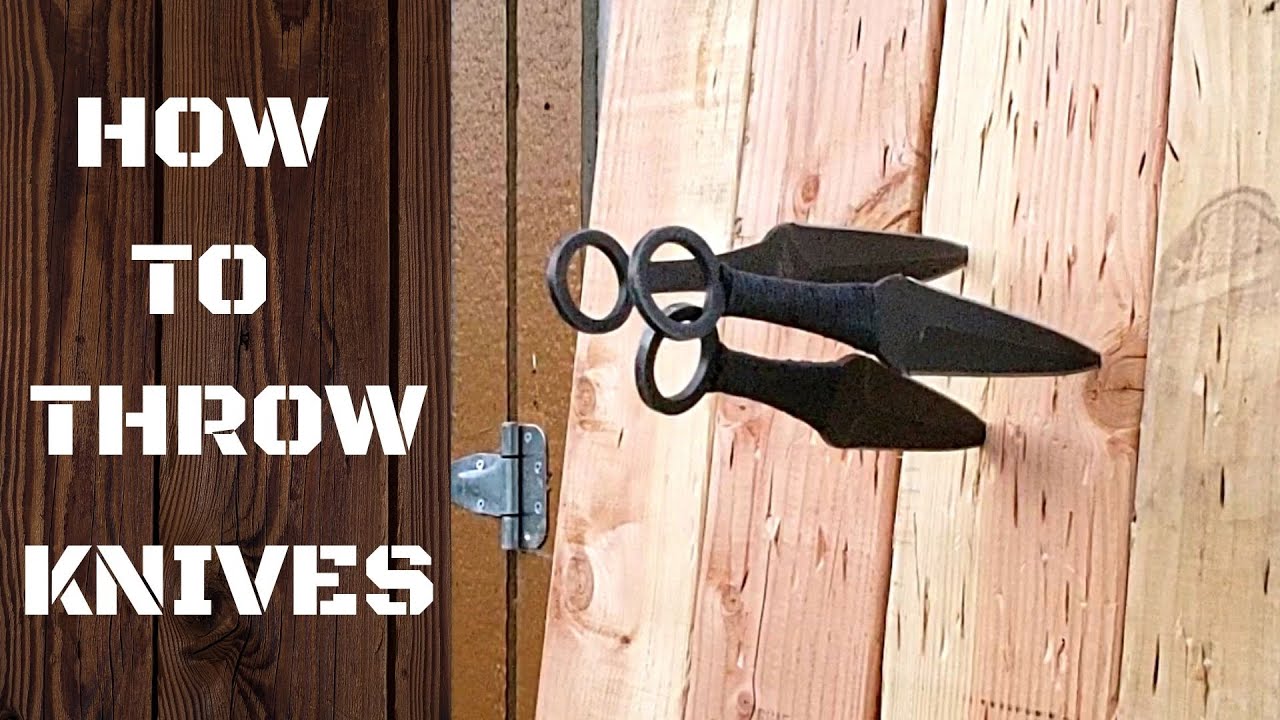Most beginning knife throwers will start out throwing overhand, as this is the most natural motion for most of us. We throw baseballs and footballs and crumpled up homework assignments overhand, so that’s most likely how we’ll start out throwing knives too.
But at some point, we want to experiment. Here are some tips to help you get the most out of your throwing, whether you go overhand, underhand, or sidearm.
How To Throw Knives Overhand
- Hold the knife straight out and point it at your target. Your arm should be fully extended, and your shoulders should be square to the target (i.e. facing forward). It’s up to you which grip you want to use, whether a pinch grip or hammer grip, or some other funky ninja grip. Your “throwing foot” (right foot if you’re throwing right-handed) should be back a full pace or more.
- Shift your weight onto your back foot while bending your throwing arm to 90 degrees or farther. This will bring your knife back past your ear and to the rear of your head. But we’re only moving the forearm; your upper arm shouldn’t move much. Keep your elbow in and pointed straight ahead, directly at or just above the target. You can experiment later with letting your elbow drift out to the side and doing baseball-style throws, but for now, keep it nice and tight.
- Now – while keeping your elbow aimed at the target – rock forward again, forcefully straighten your arm, and release the knife just before full extension. Finding that “sweet spot” in your swing – were to release the knife – takes a lot of practice and depends on how hard you’re throwing, how heavy your knife is, and how far away the target is.
This style is more or less how knives are thrown in competitions and knife throwing games. There’s a lot of triceps action here, so some throwers may have difficulty initially in generating enough power for long-distance throws with heavy knives. But it’s great for beginners because it makes for very accurate knife throwing. It is by no means the only method of overhand throwing, nor would I want to imply that it is best for everyone.
But for a beginning thrower, it’s a great place to start.
How To Throw Knives Underhand
Once you’re sticking those overhand throws, you should give underhand throwing a try.
For spin throwing, use a palm down grip on the knife, holding it by the handle or blade, depending on your distance. Keeping your arm straight, just bring it back behind you and step forward as you swing your arm forward. Release when the knife is pointing at or just above the target and allow your arm to continue along its arc. Follow-through is very important for underhand throwing accuracy.
For no-spin throws, use a palm-up grip with your index or middle finger along the spine of the blade. The steps are the same as for spin throws: step forward with your throwing foot and swing your arm up. This time, however, allow your arm to stop at the release point. Release your grip and the knife’s momentum will cause it to slide right out and sail towards the target.
If you’re pretty good with overhand no-spin throws, like Thorn-style, for instance, then you can try applying that same finger flick as you release and follow-through as usual to steady the knife and keep it from rotating in the air.
The motion is almost like scooping or shoveling action. You’re almost not even gripping the knife – just cradling it in your hand and using your fingers as guides to send it on a straight path.
How To Throw Knives SideArm
If you suck at overhand and underhand throws, then you’ll suck at sidearm too, so you’ll probably want to practice the other methods for a while before trying to tackle sidearm throws.
The motion for throwing sideways isn’t all that different than regular throwing. Throwing your knife with a backhand motion is similar to throwing underhand – but out to the side. Throwing it with a forehand swing is similar to throwing overhand – but out to the side.
The difficulty, though, is in finding that sweet spot for releasing the knife. If your release timing is off by just a fraction of a second, you could completely miss your target board and have to go searching for your knife in the grass. So make sure your overhand throwing is good before trying forehand side throws, and make sure your underhand technique is good before trying backhand sidearm throws.
Or be prepared to spend a lot of time retrieving your throwing knives.







